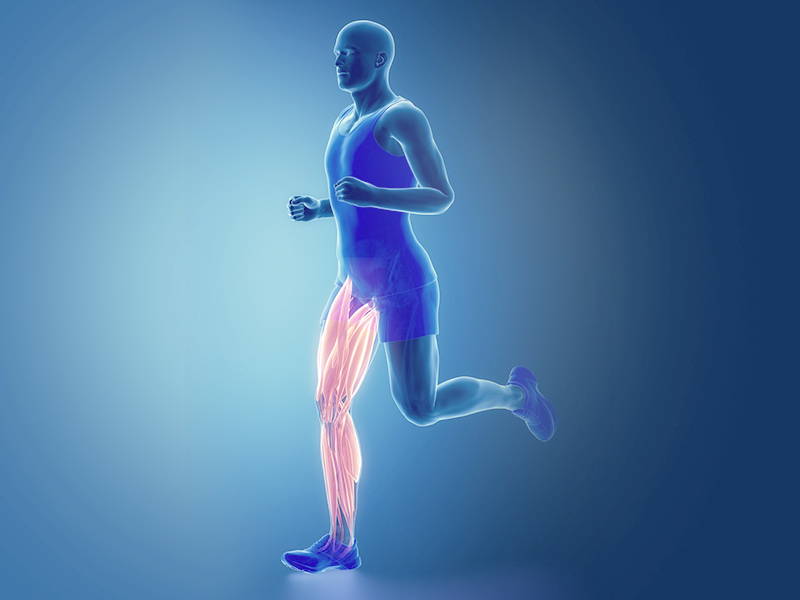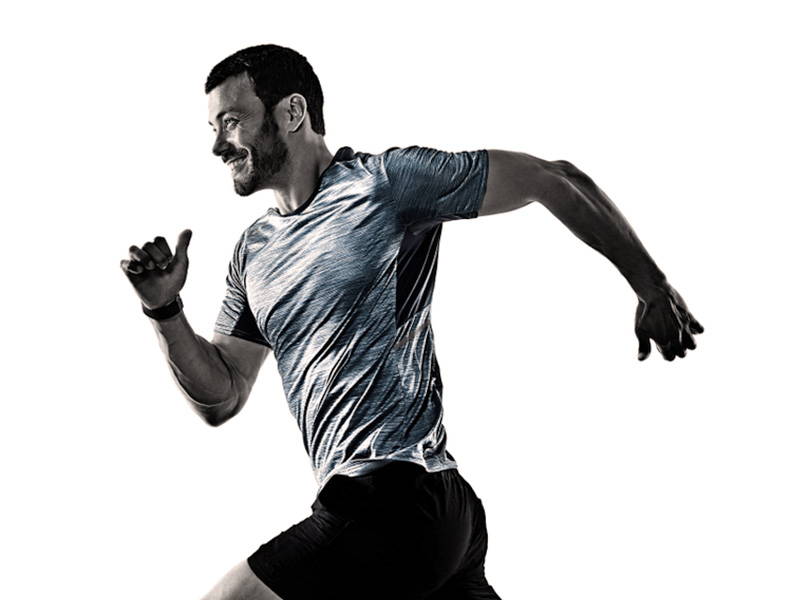
Sprinting vs. Jogging: Which is Best For Your Body?
Key Takeaways
- Sprinting and jogging are different forms of cardio that have various health benefits.
- Sprinting is a high-intensity interval training method that can help shred fat, build muscle, and improve stamina.
- Jogging is a slow-paced form of exercise that is great to use during warm-ups. It also has cardiovascular and other health benefits and can slow down the signs of aging.
- In the battle of sprinting vs jogging, your goals and starting point will help determine which exercise method is best for you.
When doing a running-type exercise, do you have a preference between sprinting and jogging?
Some people may argue that steady-state cardio like jogging has more benefits than sprinting. However, the benefits of sprinting can’t be ignored and will be discussed in later sections.

When considering your health and fitness goals, do you think sprinting or jogging is better to help you achieve them? Today, we’re going to discuss the battle between sprinting vs jogging to see if one stands out.
First, we’ll discuss the difference between the two and what muscles are used. Then, we’ll go over different goals you may have to see which exercise is best. Finally, we’ll offer some tips to improve your stamina and strength to run longer and faster.
What’s the Difference?
What is the difference between sprinting vs jogging?
- Jogging – a leisurely or slow-paced form of running, usually for distance.
- Sprinting – a fast form of running over a short amount of time and distance.
Jogging is usually done as a form of aerobic exercise. Sprinting, however, is a sport that has been around since the Ancient Olympic Games. Even now, there are still track and field sports that include sprints, at different lengths:
- 100 meters = 328 feet
- 200 meters = 656 feet
- 400 meters = 1,312 feet
While the distance may seem small, it can take a lot of training to get to a point where you can compete professionally.
After all, the fastest man in the world, Usain Bolt, ran the 100-meter dash in just 9.58 seconds. Florence Griffith-Joyner is the fastest woman, having run the same race in 10.49 seconds.
But if you aren’t planning on competing on a professional level, is sprinting still the best form of exercise for you? When it comes down to the specific goals you have, it might be.

Today, we’re going to discuss the battle of sprinting vs jogging. Whether you have certain workout goals or face some health issues, one may be better for you than the other.
Before we get started, do you think one will win out over the other? If so, let us know in the comments section what you think and if you were right after reading this article.
Now, let’s see what muscles are worked when sprinting and jogging, then we’ll get ready for the battle.
Muscles Worked: Sprinting vs Jogging
Both jogging and sprinting use the lower body primarily. But do they both focus on the same muscles in the lower body?
Muscles worked when Sprinting
Sprinting is done at higher speeds compared to jogging. The muscles used when sprinting are:

- Hamstrings
- Glutes
- Quadriceps
- Hip flexors
- Calf muscles
- Core
The arms are also used when sprinting, though to a lesser degree. Are the muscles used any differently when jogging?
Muscles worked when Jogging
It turns out, the same muscle groups are used when jogging as sprinting. The biggest difference besides speed to complete the exercise is the way the muscle fibers are activated.

When sprinting, the fast-twitch muscle fibers are activated. During jogging, the slow-twitch muscle fibers are being developed. What’s the difference between them?
- Slow-twitch (type I) muscle fibers: fatigue resistant and stabilizing during aerobic exercises.
- Fast-twitch (type II) muscle fibers: larger, faster to fatigue, and has short-term contractions to create explosive power, build strength, and muscle mass.
The body utilizes slow-twitch muscle fibers first and then when the force needed exceeds their ability, the fast-twitch fibers take over.
The difference between the muscle fibers actually explains the difference between sprinting and jogging pretty well. Sprinting is a fast-paced, explosive exercise while jogging is a slow-paced, endurance style exercise.
Now that we see how the same muscles are used for each exercise, let’s get ready for Battle: Sprinting vs Jogging.
Sprinting vs Jogging for Health and Fitness
When it comes down to whether sprinting or jogging is better for your health or fitness goals, it depends.
Are you talking about something like heart health or are you concerned with building muscle? Maybe you’ve had a knee injury before and you’re concerned with which would be better.
Let’s look at some of these to see which would be better to meet your health goals.
Heart Health
If you are looking to improve your heart health, do you think sprinting or jogging would be a better choice? When it comes to improving your cardiovascular health, you’ll want to focus on jogging.
Now, that’s not to say that sprinting isn’t good for your heart. Just that the cardiovascular benefits are better when jogging or running.
This is largely because of the steady pace you run while jogging. As you continue to train, you’re able to go longer distances without taking a break. This is how marathon and distance runners start out.

As you progress in your aerobic exercise, you can increase your VO2 max. Your VO2 max is the maximum amount of oxygen your body can use at once. The higher this number, the longer you can exercise with no need to stop.
Improved cardiovascular health not only keeps you young, but it can also help keep your brain healthy. As you age, you’re more susceptible to diseases, especially in the area of the heart and in the brain.
Keeping your body moving through aerobic exercise has a host of benefits that can slow down aging. Most of these types of diseases, like CVD and atherosclerosis, take years to develop.
Maintaining a healthy level of aerobic exercise over the years can reverse or eliminate disease progression.
Now that we know what’s best for those focusing on heart health, what do you think is best for knee health?
Knee Health
Patellofemoral pain syndrome, more commonly called “runner’s knee”, is a common injury with runners. It makes sense, given the name. When comparing sprinting vs jogging for your knees, is one better to prevent injury?

Not necessarily. Runner’s knee is usually caused by weak or tight hip and quad muscles. It can also be caused by:
- The way you strike the ground with each step
- Bad form
- Not wearing the correct shoes for your gait and foot
- Uneven or unforgiving running surface
Figuring out the problem and working to correct it can help relieve pain from runner’s knee. It can also help reduce any further injury to your joints and muscles when jogging or sprinting.
When it comes down to it, you need to make sure you have proper form, shoes, and surfaces for either exercise. This is the best way to avoid injury and sideline you from other workouts.
The explosive nature of sprinting can actually have a greater effect on your knees than jogging. However, that doesn’t mean that jogging is better. Long-term, jogging and running can also cause injury.
But what if your next goal is to improve your core strength? Let’s see which would work best there.
Improve Your Core
You’re trying to build up your abs but aren’t sure if sprinting vs jogging is better for you. When it comes to improving your core, sprinting would be better.

The high-intensity nature of sprints vs jogging helps to reduce stubborn visceral and abdominal fat. It can also help reduce:
- Overall fat-free mass
- Waist circumference
- Trunk fat
And can increase overall aerobic power. Building up your endurance during sprinting workouts will also help burn calories long after your workout. This is known as the excess post-exercise oxygen consumption or EPOC.
If you’re looking to lose stomach fat and improve your core support while building abs, focus on sprints over jogging. Is the same true for losing overall body fat if weight loss is your goal?
Lose Weight
If you want to lose weight before you work on your abs, would you rather do sprints or jog? While we think that sprinting is the way to go for similar reasons as building abs, don’t discount jogging.
In order to lose weight, you need to burn more calories than you consume. You can cut out calories by making changes to your diet, but you still need to incorporate exercise into your routine. Jogging for just 20 minutes a day can burn over 250 calories in a 185-pound person.

Depending on your current weight when starting, jogging may be better in the beginning. If you’re brand new to running, you’ll want to start with walking first. Once you can build up to 20 minutes of brisk walking without stopping, you’re ready to begin jogging.
When you can jog for at least 20 minutes without stopping to rest, you can start running or work on sprints. The prep work with walking to jogging helps you build-up endurance so that your body can handle more demand.
Now’s the time to work on your sprints as a form of speed exercise. This can be as simple as using a flat surface, or you can challenge yourself on a hilly incline. The amount of time is up to you, but start out small and work your way up.
When comparing jogging vs sprinting with a weight loss goal, start with jogging and work your way up to sprinting. Once you’ve reached your goal weight, you’ll probably want to focus on building muscle.
Do you think sprinting or jogging would be best for that workout goal? Let’s find out.
Build Muscle
Every bodybuilder, including those in the Golden Era, has a common goal to build muscle. If you’re looking to gain muscle while bodybuilding, would you choose sprinting vs jogging? If you said yes, then you’d be right.
Similar to the reasons that sprinting is better to build abs than jogging, the same is true for building muscle. According to this study, sprinting may be able to help build muscle better in women than men.

Participants included nine men and eight women, all healthy and active. Each person completed 30-second sprints followed by 20 minutes of rest. Blood samples and muscle biopsies were taken before and after to determine the results.
At the end of the study, researchers found higher serum insulin and cell growth in women than men. This study concluded that for sedentary but healthy men and women, muscle response from interval training is similar.
If building muscle is your goal, then it would be a good idea to include high-intensity exercise like sprinting.
Lifting heavy weights should be your primary focus. Add in sprint intervals once or twice a week, keeping this in mind:
- Never do sprints and legs on the same day or back to back days
- Always have at least one rest day between HIIT days
So, if you’re looking to build muscle, get toned, and reduce body fat, sprinting is the way to go. Jogging can still be utilized during warm-ups or to get your cardio in for the week.
What if I Want to Get or Stay Lean?
If you don’t want to build muscle and instead want a lean physique, then jogging is the way to go. Consider this, if you’ve ever compared pictures of a distance runner and a sprinter, you can clearly see the difference in their body composition.
If running marathons or competing in distance trials is more your speed, then you’ll want to focus on jogging. You can build up your endurance with jogging as part of your running routine and spend less time in the gym.

If getting or staying lean is your goal, focus on jogging and running at least four times per week. Add in more time and/or miles to your route each time you hit the road.
However, that doesn’t mean you should forego resistance training completely. Even if you don’t have a goal to build muscle, you should at least get one full-body workout per week. Resistance training will:
- Strengthen joints and ligaments to prevent injury
- Improve balance, mobility, and flexibility
- Improve performance and VO2 max
If you’d rather not hit the gym, then consider bodyweight exercises you can do at home:
- Planks
- Push-ups
- Lunges
- Squats
- Dips
- Glute bridges
- Superman
- Calf raises
Tips to Build Stamina and Speed
Whether you want to get better at jogging, sprinting or both, these tips can help you succeed. Increasing both your speed and stamina can also help you excel in sports and overcome a strength training plateau.
Intervals
Mix up your training intervals each time you hit the gym or workout at home. This has a few benefits, including:
- Improving your VO2 max
- Reducing boredom or complacency in workouts
- Increasing calorie burn

What does it mean to mix up your training intervals? Here’s an example:
- Warm-up for 5 – 10 minutes: start out at a fast walk for a few minutes, then jog for another few. Slow back down for a minute, then pick up the pace to a sprint to finish out your warm-up.
- Mix up your running workout:
- Jog for a minute then walk for 30 seconds
- Sprint for two minutes then jog for a minute then rest for a minute
- Run at a fast pace for a minute then rest for a minute or 90 seconds
- Cool-down for 10 – 15 minutes: use the same method to cool down as you did to warm-up. End your cool-down with a few minutes of walking.
The key here is to do random intervals without a pattern. When doing the high-intensity sprinting and running, be sure to rest for longer periods than walking and jogging.
If you’re a beginner, you may need to shorten the amount of time you spend until you can reach longer intervals.
Cross Train
This is more than just adding weight training to your workout routine. You can also do other things to shake up your routine. Here are some ideas:
Use the treadmill or elliptical. One benefit of using a machine is that you can set different inclines and speeds. Pick a predetermined but challenging workout or set it to random to up the ante.
Swim laps. Take advantage of the pool and use it either as a way to cool-down or as aerobic exercise. The resistance provided by the water also helps to build strength and work your upper body. Choose to swim at the same pace or mix it up between laps.

Use a bike. Whether you use a stationary bike at the gym or hop on your mountain bike, use it to do intervals. You can use the same method as listed above to create a great randomized workout.
It reduces the impact on your joints and also helps build stamina and strength to run uphill. Change up the tension and stand up at some points to add to the challenge.
Using intervals and cross-training are just some ways to improve your strength and stamina. Combining them with weight training can really help improve your sprint speeds and jogging distance.
The Final Verdict
Sprinting is a smart form of exercise to help you build muscle and lose fat. It’s also a great way to get your exercise in with less time. Due to the high-intensity nature of this exercise, you want to limit sprints to no more than twice per week.
Jogging is great for your cardiovascular health and can actually slow down signs of aging. If you have a family history of certain diseases or just want to ensure your heart stays healthy, consider jogging.

For some people, adding in both forms of exercise may be the best solution. For others with different goals and health concerns, one may be a better fit than the other.
When determining if sprinting or jogging is best for you, assess your goals and health to make the best decision. You may conclude that one works better for you or you need to do a mix of both. For instance, jogging can be a great warm-up exercise while sprinting works well during HIIT routines.
Do you have a preference for sprinting vs jogging, or do you mix both into your routine? Who did you think the winner would be when we started this battle? We’d love to know your thoughts in the comments section below








